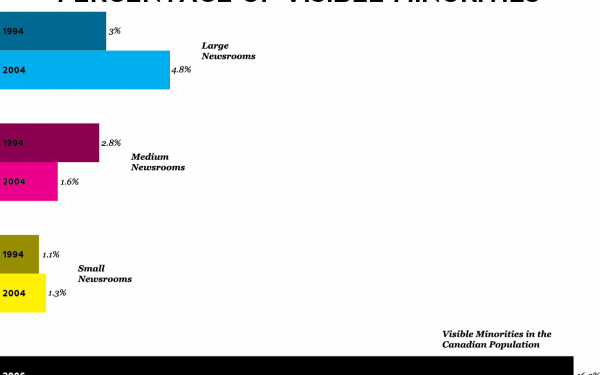It’s Hard Out Here for a Pimp—and a Journalist of Colour
Confronting the Lack of Cultural Representation in Canadian Media
It’s hard out here for racially ambiguous People of Colour—like your girl—in the field of journalism. In a métier of permeating whiteness, trying to “get this money for the rent” still isn’t as easy as it should be for marginalized up-and-coming journalists.
If you didn’t catch the bitter truth in my wildly understated Three 6 Mafia reference, let me drop a barefaced fact in this bitch: the overwhelming majority of journalists across all Canadian media are white. It should not come as a shock that recently updated data to substantiate this thesis remains to be found. It’s no surprise that newsrooms and other organizations are not pushing for data on racial diversity to be presented, mostly due to the simple fact that saying the taboo out loud is bad juju.
One of the extremely limited, more recent datasets on diversity in journalism, published in 2010 by CBC/Radio-Canada, showed that non-white minorities made up eight per cent of its reporting staff—and in a 2004 publication by the Canadian Task Force for Cultural Diversity on television news, visible minorities accounted for just over 12 per cent of Canadian anchors.
(If you’re reading this, it’s too late for righteous touting about Mitsumi Takahashi as the bastion of diversity in newsrooms.) In the same report, the organization found that minorities made up under nine per cent of reporters in English-language news. Before the Task Force’s report was published, the lone reflection of journalistic demographics in Canada was a now heavily outdated study from Université Laval in 2000, which found that 97 per cent of journalists at the time were white—97 per cent! This ain’t that Off-White that white people love so much—that’s that white-white.
Unless you live in an acid-induced dreamland, it would be fairly reasonable to ascertain that this statistic has failed to drop by 50 per cent in 20 years—especially without newsrooms placing emphasis on ensuring that more People of Colour enter the workforce. Any less of an increase in employment opportunities for marginalized journalists would be laughable and impertinent.
If you’ve ever been concerned about the total lack of urgency and prominence placed on diversifying newsrooms, you may have heard the age-old excuse many editors love to bank on when being pressed on why they don’t hire more journalists of colour. “They’re just not applying,” they say. “Our applications from visible minorities are so low. We just can’t help it if white people apply!”
Any sensible public relations rep for a prominent news organization would state facts on this phenomenon to put themselves ahead of their competitors, but no news outlet has blatantly said what it claims to so desperately seek in its line of work—the hard truth.
The fact is, visible minorities remain particularly undriven to join the workforce of journalists in Canada because they do not see others that look like themselves in the news industry. Why would you pursue a career path in which you’d stick out amongst your vanilla-faced peers like Evander Holyfield’s gnarly, chewed-up ear?
To the nonbelievers: you don’t have to search far and wide to see the effect of whitewashed journalism in action. Take, for example, our very own journalism program at Concordia.
As I reach the bitter end of a nearly five-year undergrad in this program, having had journalism classes with most of the same 15 or 20 people over the course of my education, I can count the number of visible minority students and professors in my classes on my elongated, manicured nails. In fact, I don’t think I’ve ever had a racially marginalized journalism professor. It should be noted that no data is publicly available on student and faculty demographics at Concordia.
So what can news organizations and educational institutes do about our plight? Diversifying journalism should be a top priority for institutes that are training the future of Canadian news. So should publishing data on demographics to bring to light the absolute lack of diversity in journalism programs and in newsroom employees.
Public acknowledgment of this issue should not be avoided, but encouraged—People of Colour want to know what you’re doing differently than past leadership.
The reasons behind our sad existences as journalists of colour are discernible. Students are often pressured by their families or cultural norms to pursue specific degrees and careers. But the culture of journalism in Canada will not change until all journalistic bodies shift their focus to not only hiring journalists of colour, but reporting on issues that affect journalists of colour and purposefully representing minority groups even with a lack of marginalized employees.
Racial minorities represent an increasingly significant portion of our population, and their voices should be a priority that deserve to be heard—just as much, or, dare I say, even more than Andrew Coyne’s archaic, meaningless drivel that Canadian media salivates over.


_600_832_s.png)




